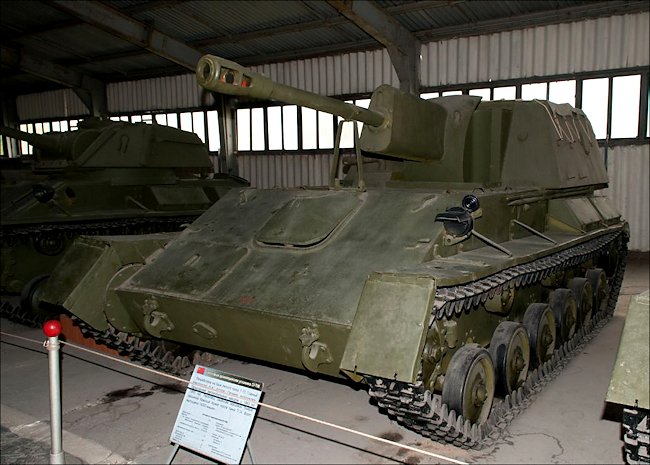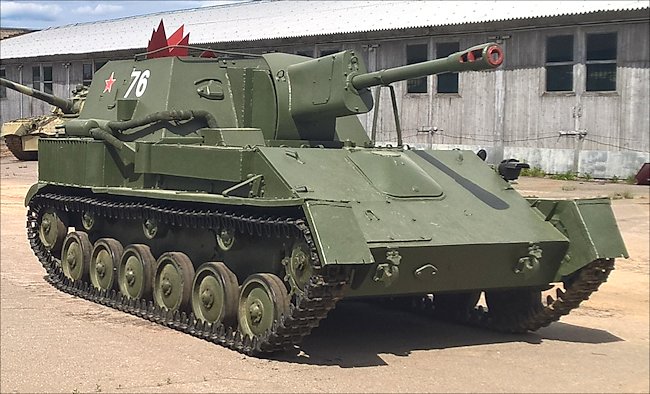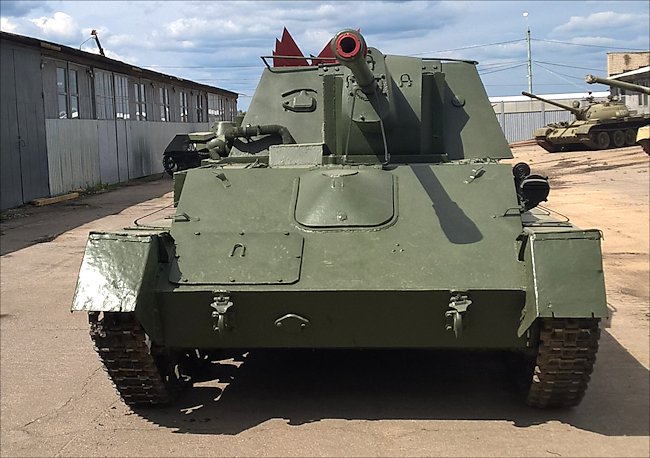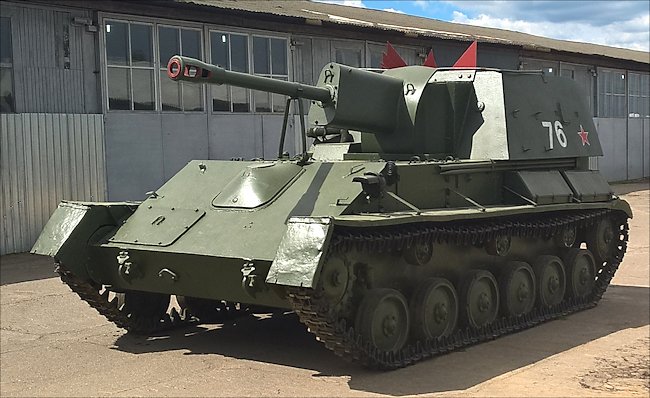SU-76M Self Propelled Gun
This SU-76M Russian Soviet 76 mm SPG at the Kubinka Tank Museum near Moscow Russia. Notice it has a canvas cover to give shade to the crew in the summer and protection from rain and snow in the winter.

This SU-76 Russian SPG can be found in the Kubinka Tank Museum near Moscow Russia
Location
Take the train from Moscow's Belorusskaya Railway Station, in the north west of the city, to Kubinka. It is about an hours train journey. It is a direct service, no need to change, and the the tickets are cheap. Make sure you print off a list of station names so you can check off where you are and get ready to get off the train at Kubinka. The station names are not always easy to read or see.
Although this military town has been active for over 80 years it has a rundown look to it. You can walk to the museum but there is the equivalent of a motorway crossing your route. There are no pedestrian crossings over it. There are a number of taxi stands near the station. They are very cheap and honest. I tried to give the driver a big tip but he refused. Ask for his card so you can ask the Museum gate staff to call his company when you are finished at the Museum to get back to the railway station.
Specifications
The SU-76 SPG was built between 1942 and 1945. Records show that 360 of the original SU-76 were built and 13,932 SU-76M self propelled guns left the factory gates. It was powered by two GAZ 203 engines that both produced 85 hp. It had a top road speed of 45 km/h (28 mph) and had a good operational range of 320 km (200 miles) before the crew had to refuel
It was armed with a 76 mm ZIS-3Sh gun that could fire high explosive HE rounds as well as armour piercing AP shells. The crew were protected by armour that ranged in thickness from 16mm on the side to 35 mm on the front. This was enough to stop small arms fire.

This SU-76 Russian SPG can be found in the Kubinka Tank Museum near Moscow Russia
Development of the SU-76
The SU-76 Light Mechanized Gun In April 1942, the GAU proposed a programme for the development of mechanized artillery, but the tank force, tired of the GAU's lagging, had already undertaken steps to design such weapons. Malyshev's Commissariat for Tank Industry set up a Mechanized Artillery Bureau (BAS) at UZTM in Sverdlovsk, under the tank designer L. Troyanov who was working in co-operation with the main artillery design teams of Generals Petrov and Grabin.
Development of a light mechanized gun was entrusted to Zavod Nr. 38 in Kirov; ofa medium mechanized gun to UZTM in Sverdlovsk, and of a heavy mechanized gun to Tankograd. Early in 1942, the design team at Zavod Nr. 38 in Kirov began its work on the light mechanized gun based on a T-60 chassis, known as the OSU-76 (Opytnaya Samokhodnaya Ustanovka: Experimental Mechanized Mounting).

This SU-76 Russian SPG can be found in the Kubinka Tank Museum near Moscow Russia
This vehicle used the standard ZiS-3 76.2mm divisional gun mounted on the rear of a modified T-60 in a partly armoured casemate mount. The OSU-76 project was dropped because of the inadequate size of the chassis and because of the work being done on the larger T-70 at the time.
In the spring of 1942, the Grabin team at Zavod Nr. 92 in Gorki, in co-operation with the Zavod Nr. 38 design team, began work on the SU-12, a mechanized 76.2mm gun mounted on a lengthened T-70 chassis. The general configuration of this vehicle was much the same as the earlier OSU-76, except that it was considerably larger.

This restored working SU-76 Russian SPG can be found in the Kubinka Tank Museum near Moscow Russia
Trials were conducted later in the summer of 1942. The GKO accepted it for production in December 1942 as the SU-76 light mechanized gun. It was intended to provide fire support for rifle and tank formations, and to act as a tank destroyer. A total of 26 were completed in 1942.
Curiously, the SU-76 retained the awkward twin-engine arrangement of the early T-70 which had already been terminated on the T-70 assembly line. It is not clear why this unacceptable arrangement was permitted, unless there was a significant shortage of transmissions and differentials of the type being used on the T-70.
Not surprisingly, the system proved every bit as unreliable as on the early T-70, leading to denunciations of the vehicle from the hapless crews who received it. In the spring of 1943, design responsibility was shifted to Astrov's bureau, where the problem was rectified by employing the modified configuration of the T-70M with the two engines in-line. This forced a redesign of the forward hull, and at the same time, some improvements were made in the rear casemate.
The improved type was designated the SU-76M and production began immediately at GAZ and Zavod Nr. 38. GAZ became the predominant manufacturer of the type, and eventually Zavod Nr. 40 in M'tishchi near Moscow also became involved in SU-76M production. All of the earlier SU-76 were withdrawn from front-line service once the SU-76M became available.
Although the SU-76M did not prove to be an entirely successful tank destroyer, because of the growing trend towards heavier tanks in the Wehrmacht, the SU-76 proved useful as an assault artillery vehicle, and was produced in greater numbers than other Soviet armoured vehicles of the War excluding the T-34.
It was doled out in generous quantities to support rifle divisions, and in many respects became a successor to the infantry tank. It was never very popular with its crews; it had very thin armour, and was one of the few Soviet AFVs not to have full armoured coverage.
The open rear made it very unpleasant to serve in during harsh weather, and made it vulnerable to small arms fire and grenades, But you can see in these examples at Kubinka a Canvas Cover was used to keep the rain out. The driver's station was adjacent to the engines without a bulkhead which was unpleasant in summer.
Its nickname in service was 'Suka' which was both the diminutive form of its acronym SU (pronounced 'soo' by the troops), and the Russian word for 'bitch'. In 1943, the Astrov team attempted to correct the complaints about the lack of overhead armour by building a fully-armoured version on an old SU-76, called the SU-76B, but the added weight affected performance adversely, and it was not accepted for service use.
Where can I find other preserved Russian SU-76M SPGs?
- Militärhistorischen Museum der Bundeswehr, Dresden, Germany
- Heeresgeschichtliche Museum, Vienna, Austria
- Polish Army Museum, Warsaw, Poland
- Polish Army Museum, Fort IX Czerniakowski, Warsaw, Poland
- Armoured Weapons Museum, Land Forces Training Centre, Poznań, Poland
- Muzeum Oręża Polskiego w Kołobrzegu, Kołobrzeg, Poland
- Jacek Kopczyński Collection, Łódz Poland
- Army Technical Museum, Lesany, Czech Republic
- Military Barracks, Banja Luka, Bosnia and Herzegovina
- Eesti Vabadusvõitluse Muuseumi, Lagedil, Estonia
- Korsun-Shevchenkivskyi, Cherkasy Oblast, Ukraine
- Muzeul Militar National, Bucharest, Romania
- National Museum of Military History, Sofia, Bulgaria
- Military area near Sliven, Bulgaria
- Stored in a barrack, near Vratsa, North Bulgaria
- Central Armed Forces Museum, 2, Ulitsa Sovetskoi Armii, Moscow, Russia
- Kubinka Tank Museum, Moscow, Russia
- Military Historical Museum of Artillery, Engineer and Signal Corps St.-Petersburg, Russia
- Pskov, Pskov Oblast, Russia
- Vadim Zadorozhny Museum, Arhangelskoe, Moscow Oblast, Russia
- Mytishchi, Moscow Oblast, Russia
- Sapun Gora, Sevastopol, Crimean Peninsula, Russia
- Kremlin of Nizhny Novgorod, Nizhny Novgorod Oblast, Russia
- Museum of military equipment "Battle Glory of the Urals" Verkhnyaya Pyshma, Sverdlovsk Oblast, Russia
- The Tank Museum, Beijing, China
- Victorious Fatherland Liberation War Museum, Pyongyang, North Korea
- U.S. Army Center for Military History Storage Facility, Anniston, AL, USA
- National Museum of the U.S. Marine Corps storage lots, Quantico, VA, USA
- Bovington Tank Museum, England
- SU76i - Central Museum of the Great Patriotic War 1941 - 1945, Park Pobedy, Moscow, Russia
- SU76i - UMMC Museum of military equipment 'Battle Glory of the Urals Verkhnyaya Pyshma, near Yekaterinburgt, Sverdlovsk Oblast, Russia
- SU76i - Sarny, Rivne Oblast, Ukraine
- Source - Pierre-Oliver Buan - http://the.shadock.free.fr/Surviving_Panzers.html
WW2 tank books
